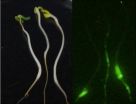(Press-News.org) Photosynthesis is arguably the most impressive feat of nature, where plants harvest light energy and convert it into the building blocks of life at fantastically high efficiency. Indeed modern civilization became possible only with the cultivation of plants for food, shelter and clothing.
While scientists have been able to discover details of the fascinating process by which plants store solar energy as chemical energy, how developing plants build and regulate their solar reactors is still poorly understood. How many genes are involved, and which are the most important? How are different cell types endowed with specific biochemical capacities? What signals fine-tune how much sugar is produced, and which bioproducts are generated? The answers to these questions have applications in agriculture, bioenergy and climate change.
Complex and multifaceted questions such as these can be addressed using a new approach to measure gene expression using high throughput sequencing. This method, coined RNAseq, is detailed in a new report from scientists at the Boyce Thompson Institute for Plant Research (BTI) and Cornell University published online in the journal Nature Genetics. The study, using the agronomically critical maize (corn) plant as a model, tracks through massive sequencing of gene transcripts, the full complement of expressed genes in a corn leaf. The researchers found that as the leaf develops, entire suites of genes are turned on and off. "Previous studies have often focused on understanding one gene or set of genes that underpin a specific pathway or process", notes Tom Brutnell, an associate scientist at the BTI and the senior author of the study, "However, these new tools have let us examine the expression of all genes in the leaf at very specific stages of development. This provides an unprecedented view of the genetic circuitry of the leaf."
While such results are exciting, they also pose big challenges as scientists work to interpret the datasets. In this study, over 25,000 genes were found to be expressed in each leaf, and nearly half of these are transcribed into at least two different forms, called splicing variants. To make sense out of this flood of information, scientists at BTI, Cornell, Yale, Iowa State and the University of Toronto collaborated to develop systems biology tools that combine computational and statistical methods to analyze large datasets. "The interface between developmental biologists, molecular biologists, and computer scientists that made this work possible, is an excellent example of why systems biology is able to unravel complex biological pathways" commented David Stern, President of BTI.
An important aspect of this work is that it provides insight into the regulation of the unusual form of photosynthesis that maize utilizes referred to as C4 that increases water and nitrogen use efficiencies under hot dry environments. "Some of the most productive food, feed and bioenergy crops utilize C4 photosynthesis including maize, sugarcane and the bioenergy grass Miscanthus", notes Brutnell "This study provides the first comprehensive analysis of gene expression in any C4 plant and thus provides the groundwork for a genetic dissection of this process".
Given the economic importance of C4 plant in the United States and around the world, these findings have numerous potential applications to agriculture. Optimizing photosynthetic capacity could not only enhance the performance of maize, but also enable far-reaching transformations of photosynthesis in species which are currently far less efficient than maize, such as rice or wheat.
INFORMATION:
Co-authors included Pinghua Li, Lin Wang and Tesfamichael Kebrom, BTI postdoctoral researchers; Lalit Ponnala and Edwin Reidel, postdoctoral researchers at Cornell, Qi Sun and Chris Myers at Cornell's Computational Biology Service Unit, and Robert Turgeon in Plant Biology. Other colleagues included Yaqing Si and Peng Liu at Iowa State University, Neeru Gandotra, Lori Tausta and Tim Nelson at Yale University and Rohan Patel and Nick Provart at the University of Toronto.
The research was funded by the National Science Foundation and the Bill and Melinda Gates Foundation.
The developmental dynamics of the maize leaf transcriptome
2010-11-04
ELSE PRESS RELEASES FROM THIS DATE:
Tropical Storm Anggrek is tightly wrapped in NASA satellite imagery
2010-11-04
Bands of strong thunderstorms are wrapping around the center of Tropical Storm Anggrek in the Southern Indian Ocean, according to satellite imagery. NASA's Aqua satellite captured an infrared look at those strong thunderstorms today.
NASA's Aqua satellite passed over Anggrek on Nov. 3 at 07:05 UTC (3:05 a.m. EDT) and the Atmospheric Infrared Sounder (AIRS) instrument onboard captured an infrared image of the cold thunderstorms within the system. The image showed that strong, high thunderstorm cloud tops tightly circled the storm's center. There was also strong convection ...
NASA satellite sees Tomas weaken to a tropical depression ... for now
2010-11-04
NASA infrared satellite data from this morning revealed that Tropical Storm Tomas has weakened into a tropical depression.
Tomas is in the central Caribbean Sea headed for Haiti this weekend, and forecasters are calling for a re-intensification before it makes landfall.
The National Hurricane Center (NHC) in Miami, Fla. reported at 5 a.m. EDT on Nov. 3 that hurricane hunter aircraft found an "ill-defined and elongated circulation with no tropical storm-force winds at the flight level or the surface." Thus, the status of Tomas was changed from a tropical storm to a ...
Volcanoes have shifted Asian rainfall
2010-11-04
Scientists have long known that large volcanic explosions can affect the weather by spewing particles that block solar energy and cool the air. Some suspect that extended "volcanic winters" from gigantic blowups helped kill off dinosaurs and Neanderthals. In the summer following Indonesia's 1815 Tambora eruption, frost wrecked crops as far off as New England, and the 1991 blowout of the Philippines' Mount Pinatubo lowered average global temperatures by 0.7 degrees F—enough to mask the effects of manmade greenhouse gases for a year or so.
Now, scientists have shown ...
Headgear, mouth guards have little or no impact on reducing concussions in rugby players
2010-11-04
TORONTO, Ont., Nov. 3, 2010 – Existing headgear and mouth guards have limited or no benefit in reducing concussions in rugby players, according to Dr. Michael Cusimano, a neurosurgeon at St. Michael's Hospital.
However, educational injury prevention programs that promote proper playing techniques and enforcement of the rules do result in a significant reduction in concussions and head, neck and spinal injuries, Cusimano concluded after a review of existing studies on the topic.
Cusimano still recommends rugby players wear mouth guards and protective headgear ...
Chromosome imbalances lead to predictable plant defects
2010-11-04
WEST LAFAYETTE, Ind. - Physical defects in plants can be predicted based on chromosome imbalances, a finding that may shed light on how the addition or deletion of genes and the organization of the genome affects organisms, according to a study involving a Purdue University researcher.
The findings identify easily measured characteristics that vary with imbalances of specific chromosomes, said Brian Dilkes, a Purdue assistant professor of horticulture. Understanding why and how those imbalances result in certain characteristics could open the door to correcting those ...
E. coli thrives near plant roots, can contaminate young produce crops
2010-11-04
WEST LAFAYETTE, Ind. - E. coli can live for weeks around the roots of produce plants and transfer to the edible portions, but the threat can be minimized if growers don't harvest too soon, a Purdue University study shows.
Purdue scientists added E. coli to soil through manure application and water treated with manure and showed that the bacteria can survive and are active in the rhizosphere, or the area around the plant roots, of lettuce and radishes. E. coli eventually gets onto the aboveground surfaces of the plants, where it can live for several weeks. Activity in ...
U of M researcher finds public support for HPV vaccine wanes when linked to controversy
2010-11-04
MINNEAPOLIS / ST. PAUL, Minn. (Nov. 2, 2010) – The vaccine that protects against the potentially cancer-causing human papillomavirus (HPV) enjoys wide support in the medical and public health communities. Yet state laws to require young girls to be vaccinated as a requirement for middle school attendance have aroused controversy with parents, politicians, and even medical and public health experts disagreeing about whether such laws are appropriate. News coverage about HPV vaccine requirements tends to amplify this controversy, possibly leading to negative attitudes among ...
Organic onions, carrots and potatoes do not have higher levels of healthful antioxidants
2010-11-04
With the demand for organically produced food increasing, scientists are reporting new evidence that organically grown onions, carrots, and potatoes generally do not have higher levels of healthful antioxidants and related substances than vegetables grown with traditional fertilizers and pesticides. Their study appears in ACS' bi-weekly Journal of Agricultural and Food Chemistry.
In the study, Pia Knuthsen and colleagues point out that there are many reasons to pay a premium for organic food products. The most important reasons for the popularity of organic food products ...
Built-in timer for improving accuracy of cost saving paper-strip medical tests
2010-11-04
Scientists are reporting the development of a simple, built-in timer intended to improve the accuracy of paper tests and test strips for diagnosing diseases inexpensively at-home and elsewhere. Their study appears in ACS' semi-monthly journal Analytical Chemistry.
Scott Phillips and Hyeran Noh note that so-called point-of-care tests include paper strip tests and others performed at home or bedside instead of in laboratories. They show special promise for improving medical care in developing countries and reducing health care costs elsewhere. When fully developed, these ...
Does adolescent stress lead to mood disorders in adulthood?
2010-11-04
Montreal, November 3, 2010 – Stress may be more hazardous to our mental health than previously believed, according to new research from Concordia University. A series of studies from the institution have found there may be a link between the recent rise in depression rates and the increase of daily stress.
"Major depression has become one of the most pressing health issues in both developing and developed countries," says principal researcher Mark Ellenbogen, a professor at the Concordia Centre for Research in Human Development and a Canada Research Chair in Developmental ...





